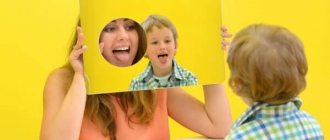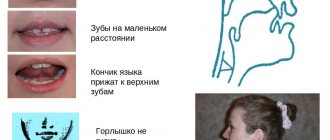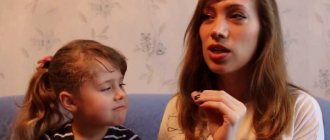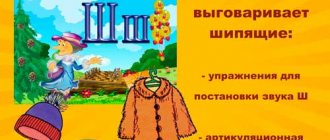Correct articulation of the sound “Z”
The sounds “З”, “Зь”, “С”, “Сь”, “Ц” are classified as whistling sounds as having similar articulation. To learn how to say the letter “Z,” let’s first clarify how the speech apparatus works.
When we pronounce the sound “Z”:
- the lips are slightly stretched, as if smiling;
- the tongue on the sides is pressed against the upper teeth, and at the bottom it rests against the lower incisors;
- a small gap remains between the rows of teeth;
- the soft palate blocks the air stream from exiting through the nose;
- the air passes along the tongue, creating a dull “C”;
- the vocal cords vibrate and “turn on” the voice, without which the sound of “Z” is impossible.
What happens when there is a defect in the reproduction of whistling sounds?
How to teach a child to pronounce the letter C?
The first step towards a solution should be taken towards finding the source of the problem, because teaching a child to say the letter C is possible only after the reason for the incorrect sound production has been identified.
Incorrect pronunciation
Reasons for difficulty
You need to pay attention to pronunciation from the age of 3. Most often, by the age of 4, the child himself corrects whistling, hissing and even [P]. If this does not happen, you need to think about the possible reasons for the delay in speech improvement:
- age-related imperfection of the speech apparatus;
- the child grows up in a family where two languages are actively used;
- flaccid tongue muscle;
- malocclusion;
- anatomical features of the tongue;
- presence in the family of people with incorrect pronunciation;
- incorrect phonemics.
Attention! If the family is bilingual, the child may borrow sounds from one language and use them in the other. Thus, the interdental sound from the English language becomes an everyday substitute for Russian [S].
A weak tongue muscle, as a cause of incorrect pronunciation, can be corrected through training. Performing simple but effective exercises will help strengthen it. At home with your child, you should play with horses more often, imitating the sound of clopping hooves. If you perform the exercise several times a day until a feeling of fatigue appears in the tongue, the muscle will quickly become stronger.
Exercise to strengthen the tongue muscle
Why does FFNR occur?
The problem of FFND affects almost a quarter of all babies. Speech underdevelopment begins to manifest itself in the first years of life, when the child learns to pronounce words. For children 2-3 years old, the problem is not critical and does not require adult intervention. In order for speech to develop in accordance with the child’s age-related abilities, you need to carefully monitor your articulation. Adult speech should not be hasty or unclear. The formation of his phonemic representation of his native language depends on how the child hears words.
Phonetic-phonemic underdevelopment of speech is manifested in the incorrect pronunciation of some letters, mainly paired consonants (t-d), by replacing complex ones with simple ones (l-r). When a child cannot distinguish sounds from a word by ear, does not perceive the difference in consonant syllables, distorted speech is formed.
Attention! If this defect is not corrected by the age of 5-6 years, it will develop into incorrect written representation of words. Children who have not been treated to correct the perception of sound by ear and its pronunciation develop dysgraphia - erroneous spelling of words, accompanied by a stable replacement of syllables in a word, and rearrangement of letters.
Features of speech development in preschool children
Preparation of the speech apparatus at home
The sound [C] is introduced in stages; classes begin with mastering the motor abilities of the tongue, which will definitely be useful for clear pronunciation of other sibilants.
Articulatory gymnastics for sounds (s, s, z, z, z)
Before you teach your child to say the letter C at home, he needs to be trained to control his tongue. A fun exercise called "Turkey". The child is told a random short rhyme about a poultry yard, after which he is asked to reproduce a turkey babble: it looks like the combination “bl-bl-bl”, but the tongue should be sharply thrown forward behind the teeth and come back, as if lining the upper lip from the inside and outside alternately.
Exercise "Turkey"
Attention! The “horse” exercise is highly effective, during which the child, sucking and lifting his tongue from the palate, imitates the clicking of hooves.
Finger exercises
Finger gymnastics brings the speech centers of the brain into an active phase, which has a positive effect on the development of speech, therefore rhythmic rhymes like “Forty-forty cooked porridge” are important in the development of pronunciation. Be sure to play for 5 minutes every day.
Working on breathing
The stages of teaching preschoolers the correct sound pronunciation include mandatory breathing work. The child needs to be taught to exhale air forcefully; to do this, a piece of paper or a “spinner” toy is placed at a short distance from him, which begins to move when there is a strong gust of air flow. The child should blow forcefully at the target, pursing his lips like a tube.
Another important lesson in breathing control is to control the rise and fall of the chest as you inhale and exhale. To turn the exercise into a game, you can place a tennis ball on your chest. When you exhale sharply, it will fall. The goal of the exercise is to throw the ball off your chest as many times as possible.
Mimic gymnastics for sound production [C]
Lessons on facial expressions with a speech therapist to pronounce the letter C are based on stretching the lips in a smile and slightly open teeth. If the lesson is held in a group of children, a competition is announced for the widest smile that will last longer than the rest.
Attention! An indicator of a correctly performed exercise will be a slight pain in the facial muscles on the cheeks.
Types of incorrect articulation of the sound “Z”
When the pronunciation of whistling sounds is distorted, it is called sigmatism; when it is replaced by other sounds, it is called parasigmatism.
There are several types of sigmatism:
- Labial-dental. With this defect, the lower lip stretches upward and the result is “B” instead of “Z” (“task” - “vada”).
- Side. The tongue on the sides, or only on one side, does not rest on the upper teeth, and the air disperses in the mouth, losing pressure and forming a squelching sound “HL” (“sunset” - “slurp”).
- Interdental. The tongue rests between the rows of teeth, creating a lisping sound.
- Nasal. The soft palate descends to the root of the tongue, exhaled air exits through the nose. This produces a nasal "X".
- Prizubny. The tongue rests on the half-closed teeth and does not allow the passing air to move freely, as a result you hear something between “D” and “Z” (“winter” - “dzima”).
- Hissing. The tip of the tongue moves towards the frenulum, it bends towards the upper palate, the lips are rounded and a hiss is obtained instead of a whistle (“lock” - “zhamok”).
Sequence of correction work
Sound production is part of speech therapy work with sound pronunciation, which takes place in stages. In general, the process looks like this:
Only sequential passage of all stages makes it possible to achieve the desired result and consolidate it.
Now let's talk about everything in order.
Preparatory stage
At the preparatory stage, the correct sound and articulation of the formed “Z” is demonstrated. Articulation and breathing exercises are performed to prepare the child to perform basic positioning exercises.
Sound production
There are several ways to set the sound “Z” for speech therapists:
Imitation performance
The child is explained how the organs of the speech apparatus should be located and move, and how “Z” sounds. He repeats after the speech therapist both the isolated sound and the syllables containing it. With this method of presentation, cards, layouts, and illustrations are used for clarity. This makes the process of sound reproduction understandable and conscious.
Mechanical method of installation
When staging sound pronunciation using this method, the position of the speech organs is corrected by auxiliary means, for example, probes, spatulas or fingers.
So, with an interdental defect, the tongue is moved behind the lower front teeth with a spatula; and in case of labiodental, the lower lip is held by a speech therapist.
Staging from reference sounds
Supportive sounds have a reproduction mechanism similar to the impaired ones, but are pronounced correctly by the child. Therefore, staging a problematic sound based on them brings good results. The references for the sound “Z” are “I” and “F”, as well as for “S”. Corrective work on “Z” begins after setting “C”. They differ only in that the voice is used to pronounce “Z”.
Setting "Z" from "I":
- we stretch our lips into a smile and pronounce a drawn out “I”;
- Without changing position, we only try to exhale air noisily;
- when we hear, even if not too acoustically pure, “S”, we translate it with our voice into “Z”;
- We invite the baby to put his hand on the neck and feel how it “buzzes”;
- strengthening the sound, we ring longer.
And pronouncing the sound “F” makes it possible to practice a correctly directed stream of air. You can also make the sound “Z” from “Sh” and “T”.
Setting “Z” from “W”:
- pull “W”;
- move the tongue towards the lower incisors until it stops;
- when we receive a whistling “C”, we connect the voice;
- imitate the sound of a mosquito.
Setting "Z" from "T":
- as you exhale, continuously pull “T”;
- continue and smile;
- the stronger the smile, the thinner the whistling “S” is produced;
- further - according to the well-known algorithm to “Z”.
Summary of individual speech therapy lesson “Sound production [Z]”
Summary of individual lesson “Staging the sound “Z”»
Subject:
“Setting the sound “Z””
Target:
1. Correctional and educational:
- introduce the sound “Z”;
- achieve the ability to determine the position of the organs of the articulatory apparatus when pronouncing the sound “Z”;
- enriching the vocabulary with words with the sound Z, consolidating knowledge about animals.
2. Corrective and developmental:
- strengthening conditioned reflex connections to a given sound;
— development of phonetic hearing, phonemic perception;
— development of motor skills of the articulatory apparatus, finger motor skills;
3. Correctional and educational:
- maintaining interest in classes;
Equipment:
toy Bunny, carrot, mosquito.
Progress:
- Organizing time.
- Hello, let's get to know you. My name is Anna Nikolaevna, what is your name?
— Today in class we will get acquainted with a new sound from the group of whistlers and learn how to pronounce it. And it’s a mystery that will help us recognize him.
- White in winter, gray in summer.
Jump up the mountain, and somersault down the mountain (hare).
- What sound does this word begin with? (With sound Z). Today we will work on the pronunciation of the sound Z.
- Main part.
Articulation gymnastics.
– Now I’ll tell you a story about the Little Bunny.
On a cold winter day, a little bunny sat on a stump and began to remember the warm summer.
—
And you look carefully at the Bunny and do it with him.
He smiled (exercise “Smile”). (Keep a smile. Don’t clench your teeth.)
He opened his mouth and stuck out his tongue, remembering how the sun warmed him (exercise “The mouth opens”).
The little bunny didn't know that it snowed in winter; suddenly a cold snowflake fell on his tongue, the bunny got scared and hid his tongue (exercise
"Hide and Seek")
The Bunny liked playing with his tongue; he will stick it out, then he will hide it, then he will stick it out, then he will hide it.
And Bunny also remembered that in the fall he ate delicious carrots, they were as tasty for him as tasty jam for us (Exercise “Lick your lips”)
And then I brushed my teeth. (Exercise “Brushing your teeth”)
He looked at the Christmas tree, and there were a lot of needles on it (Exercise “Needle”)
Breathing exercises “Veterok”
— Suddenly the wind blew. The bare branches on the bushes began to tremble. The bunny was scared. I looked around. And the breeze keeps blowing, moving the branches on the bushes.
— Let’s show you how the wind blows (Inhale air through your nose and hold your breath for 3 seconds. Exhale through your mouth. Make sure that your shoulders don’t rise when you inhale, and your cheeks don’t puff out when you exhale.)
- Little Bunny realized then that he had nothing to be afraid of. This is all - just a breeze got tangled in the branches. The Bunny smiled and began to remember summer fun again.
Introducing the sound "Z".
— In the summer, Little Bunny met the mosquito Komar-Komarovich. Komar-Komarovich flew near the Bunny in the summer and loudly rang “Z-Z-Z”.
- How did Komar-Komarovich ring?
- Do you want to learn how to ring as well as Komar-Komarovich?
- When pronouncing the sound “Z”
a) Lips in a smile, teeth visible;
b) The teeth are close together, but not closed.
c) The wide tip of the tongue rests on the lower teeth.
d) The front part of the wall of the tongue rises to the upper tubercles and forms a gap with them
e) The lateral edges of the tongue are pressed tightly against the lateral teeth.
f) A strong cold stream of air flows through the middle of the tongue.
f) The vocal cords are tense, close together, and vibrate, resulting in
a voice is formed (control with the palm of the hand on the neck).
- Look in the mirror, smile and say the sound “Z.”
- Can you sing the sound “Z”?
– So the sound “Z” is a consonant, is the sound “Z” pronounced dull or voiced?
-How should I pronounce the sound “Z” - softly or firmly?
Umbrella, lock
– This means that the sound “Z” is consonant, sonorous and hard.
Consolidating
the pronunciation of an isolated sound
Game “Far - Close”.
- Catch a mosquito, bring it to your ear. (Z - Z - Z - loud)
Do you hear how Komar-Komarovich rings?
Now let go of Komar-Komarovich. Let it fly.
(Z – Z – Z – quiet). Flew away.
Development of phonemic hearing
Didactic game “Clap if you hear the sound [z].”
- Now we’ll play the game “Clap if you hear the sound [z].” I will make different sounds, and you listen carefully. If you hear the sound [z], clap your hands.
- [s], [z], [h,], [ts], [s,], [z,], [w,], [ts], [z], [s], [w], [ ts], [s,], [sh], [z,], [s], [ts], [sh,], [h,], [z].
Finger gymnastics
Once upon a time there was a bunny with long ears (clap their hands)
The bunny's nose got frostbitten at the edge of the forest (rubbed his nose)
The nose is frozen, the tail is frozen (clench and unclench the fingers of both hands)
And I went to warm up and visit the kids (turn the steering wheel)
It’s warm and quiet there, there’s no wolf (clap their hands)
And they give you carrots for lunch (they stroke the stomach with the palm of the leading hand clockwise)
3. Summary of the lesson.
—
And now it’s time for the Bunny to hit the road. Otherwise his mother, the hare, will lose him.
- Bunny! We know that there is little food in the forest now. We prepared carrots for you and your entire bunny family. Take her quickly to the forest and treat your whole family. (The bunny runs away).
Automation of the sound "Z"
It is not enough to just pronounce a sound; you need to learn how to use it in your speech. At the next stage after setting, the learned skill is consolidated. First in isolation, then in syllables, words, phrases and sentences.
To automate the sound “Z,” you can practice pronouncing it in poetry, tongue twisters, tongue twisters, riddles, and phraseological units.
For example,
poems with the sound "Z"
pure sayings starting with “Z”
tongue twisters starting with "Z"
And here are some more interesting riddles and phraseological units starting with the letter “Z” at the automation stage.
Puzzles:
Phraseologisms:
hack it on the nose, throw it in hats, it will heal like on a dog, kill the worm.
A speech therapy session on automating problem sounds will be more successful if it is organized in a playful way using color pictures, toys, cubes, lotto and other items.
Here are some ideas for automating “Z”:
- Ask your child to name the colors of the blocks. What color starts with " Z "? That's right, green . Let's add the green cubes separately. What toys contain the letter " Z " in their name? Bunny , bunny , dog Zina . It turns out that a hurricane destroyed their houses, and they decided to build one common house from green cubes. One day, while walking in a green forest, it started to rain. “Where are our zons ?” - the believers shouted . They rushed home, but the evil wolf Zaza was waiting for them . The little girls were not afraid; they invited the wolf to come and wait out the rain over a cup of aromatic tea with strawberry jam.
- Place the colored pictures in a row and let the child choose from them those that depict objects with the letter “Z”.
- You name the word, and the child repeats it in the plural (tooth-teeth, beast-beasts).
Regular practice is an indispensable condition for the development of any skill. Only by being determined to work methodically and with the support of a speech therapist can you help your son or daughter overcome the naughty letter.
Effective classes with a speech therapist starting with the letter C
A qualified speech therapist will not use methods that force a child to do something he does not want to do.
How does a sound production lesson work [C]
An experienced speech therapist's appointment consists of fun games, close to pampering, when a child, together with an adult, is allowed to make faces in front of the mirror and utter various funny syllables.
Individual lessons on audio automation [C]
Such exercises should be regular until the result is achieved. Mandatory exercises for the formation of the correct sound include a game of imitating the noise of a pump, a blizzard, or a deflating balloon.
In a family where adults take the trouble to communicate with the child once a day, not in a hurry, but thoughtfully, correcting the pronunciation they hear, the child will gradually begin to speak clearly in a natural environment. Care in the family, a healthy moral environment and an adequate assessment of abilities are the key to a successful and psychologically healthy child.
Automation of sounds in spontaneous speech
At the final stage, when all the steps of painstaking work on the unruly sound have been completed, it is introduced into spontaneous speech.
Try playing word games:
- Continue the phrase: “Today on the way home I...”; “I liked how...”; “I recently found out that...”
- Tell me what color is your mood. For example, pink - joyful and carefree; or gray - sad and gloomy.
- Thematic stories about how a bear lives in the zoo; why does the fox have such a beautiful tail; what a woodpecker is doing in the forest, etc.
Self-control is the key to successful work on problematic sounds
In order for all the work done to be crowned with success, it is necessary to take into account such a factor as the child’s ability to control his pronunciation. Classes with a speech therapist and communication with parents are only part of the time where control is established over the child’s speech. The rest of the time, including when communicating with peers, the child must learn to monitor his speech himself.
To prevent this from becoming an annoying chore, motivate him to overcome his speech impediment, support him during failures, and praise him for small victories over himself. Your baby will definitely succeed, don’t doubt it.
As well as the fact that he will grow into a purposeful, open-to-communication person.
Techniques for teaching sound pronunciation
In order to establish the correct pronunciation of sounds, the speech therapist carries out labor-intensive work. First, it is necessary to record the correct movements of the organs of the articulatory apparatus.
Next, you should consolidate the results obtained with exercises. When the sound “goes”, it should be trained not only in classes with a speech therapist, but also at home. To get results, parents should monitor the pronunciation of words with problematic sounds in everyday speech.
Sound production is divided into several stages:
Articulation gymnastics. A speech therapist uses various exercises to develop the speech apparatus. To pronounce correctly, you need to prepare a platform and do gymnastics before each lesson. This will allow you to better understand future exercises.
It is recommended to conduct classes continuously every day in the morning;
Sound production. There are children who can pronounce whistling sounds correctly by the age of 4. They only need to consolidate their skills in practice. And there are those who are just learning to “whistle.”
Automation. At this stage, the child, with the help of special exercises, brings the result to perfection through constant repetition.








![Producing the sound [L] to a child in stages. Articulation gymnastics, speech therapy exercises, pronunciation lessons with pictures](https://doktorobrubov.ru/wp-content/uploads/postanovka-zvuka-l-rebenku-poetapno-artikulyacionnaya-gimnastika-logopedicheskie-uprazhneniya-uroki-330x140.jpg)
